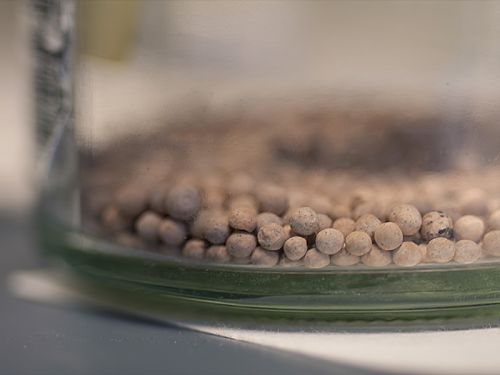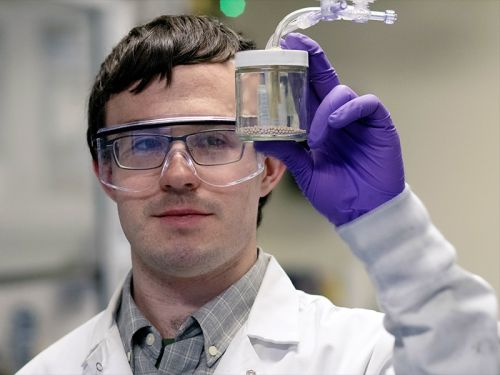
Study authors Yaguang Zhu (left) and Austin Booth stand in Kelsey Hatzell’s lab. Photos by Bumper DeJesus
By Colton Poore, Andlinger Center for Energy and the Environment
March 14, 2024
In a corner of Kelsey Hatzell’s lab sits a small jar filled with a material that has an ability far beyond what its nondescript appearance would suggest: a way to capture and release carbon dioxide from the atmosphere by simply changing the surrounding humidity.
The material could slash the energy costs associated with so-called direct air capture systems, which conventionally rely on energy-intensive temperature or pressure shifts to switch between carbon capture and release. By instead relying on humidity, the material could yield energy efficiency improvements over five times above current technologies. The researchers reported their findings in Environmental Science & Technology Letters on January 10.
Direct air capture systems have been heralded as a way to combat climate change by pulling carbon dioxide out of the air to either store permanently underground or convert into a useful product.
“There’s been an explosion of interest in direct air capture systems, because they’re not just a way to reduce carbon emissions, but to actually remove them from the atmosphere,” said research leader Hatzell, assistant professor of mechanical and aerospace engineering and the Andlinger Center for Energy and the Environment, pointing to a recent $3.5 billion effort from the U.S. Department of Energy to develop four regional direct air capture hubs across the country.
Despite its promise, direct air capture has come under scrutiny since it requires more energy to perform than almost any other application of carbon capture. That is because the concentration of carbon dioxide in ambient air is extremely diluted, especially when compared to the waste gas from a point-source emitter such as a coal-fired power plant.
One of the process’ most energy-intensive steps is regeneration. After capturing carbon dioxide from ambient air, conventional systems require heat and/or pressure changes to release the gas into storage so that the system can be prepared to capture more carbon. In one approach using a liquid solvent, the regeneration step requires heating the carbon capture material to temperatures ranging from 300° to 900°C.
By contrast, previous research has shown that regenerating carbon capture materials with humidity only requires adding or removing water vapor. Such an approach dramatically cuts the energy required to remove a ton of carbon dioxide, from up to 4.1 gigajoules using conventional techniques to just 0.7 gigajoules — an energy savings per ton greater than the energy used by the average U.S. household in a month.

To achieve the humidity-based approach, the Princeton team modified an existing type of ion-exchange resin, a material that can trade charged particles with the surrounding environment. These resins are already used for a range of commercial purposes, making them widely available and inexpensive.
Moreover, the surfaces of these resins are dotted with countless tiny pores, only 6 nanometers in diameter. The carbon capture process takes place inside these cavities. At low humidity, a series of chemical reactions occurs in the pores that allows them to capture carbon dioxide from a stream of incoming air. At high humidity, the opposite occurs: the material releases its bound carbon and is prepared for another round of capture.
“We can simply change the amount of water vapor in the system to regenerate the entire material,” said first author Yaguang Zhu, a postdoctoral researcher at the Andlinger Center for Energy and the Environment. “In this way, we can minimize the energy we put into the process.”
The researchers examined ways to control and modify the materials at the nano-scale to enable more efficient moisture-swing carbon capture. They found that loading the pores with highly basic, negatively charged ions such as phosphate and carbonate yielded the highest capacity for carbon capture.
The team also explored the physical structure of the ion-exchange resin to inform future design strategies for humidity-based carbon capture. For example, they found that while the tiny pores were important for determining the total amount of carbon dioxide that could be captured, they had little impact on the actual speed of capture. Both capacity and rate of capture are important considerations for designing and scaling up plants to meet future emissions reduction needs.
Instead, materials sporting larger pores in addition to the tiny ones could capture and release carbon at a much higher rate, as the larger pores worked to quickly transport water into and out of the material.
“The tiny micropores — only a few nanometers wide — are very important for the reversible carbon capture reaction,” said Zhu. “But we found that the larger pores were more important for transporting water, and thus had a strong influence on the rate of carbon capture.”
The researchers are continuing to investigate the fundamental science behind the material’s ability to capture and release in response to humidity swings, but they noted that the technology’s low energy costs combined with its inexpensive materials make it a promising candidate for future scale-up.
If scaled, the humidity-based regeneration approach could also present interesting opportunities to leverage

the moisture fluctuations that naturally occur in the environment to further cut down on energy costs. Co-author Austin Booth, a graduate student in chemical and biological engineering, said locations that routinely oscillate between dry and wet conditions could be ideal for this type of technology.
“You could imagine that in a place with daily humidity cycling, you could theoretically operate this process with little to no external energy input,” Booth said.
And while the technology’s carbon capture abilities naturally lend it toward applications in direct air capture, Hatzell said that the underlying science could have an impact in a range of applications, including ones in energy storage — one of her group’s key research areas.
“The fundamental science could apply to a number of different separations problems in the chemical industry,” said Hatzell. “The work is ultimately about tuning the chemistry of a material to reduce the energy you need for a given process, and that kind of information has a very broad appeal.”
The paper, “Confinement effects on moisture-swing direct air capture,” was published January 10 in Environmental Science & Technology Letters. The work was supported by the U.S. Department of Energy’s Advanced Materials for Energy-Water-Systems Center and the High Meadows Environmental Institute at Princeton University.